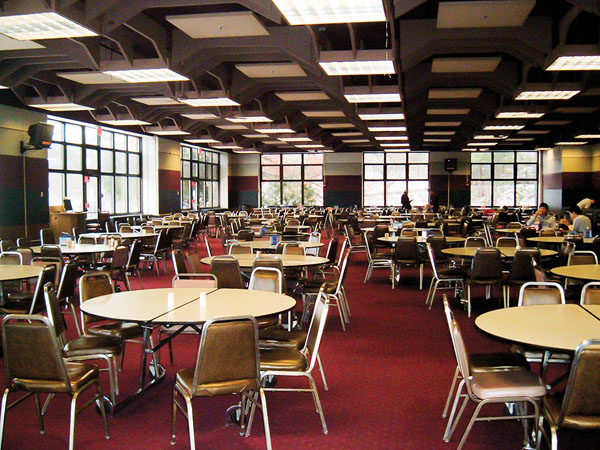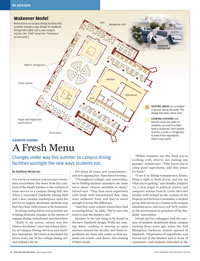In Review
 (Photo: Dining Services)
(Photo: Dining Services) BEFORE & AFTER: The current dining area in Danforth (above, top) will be replaced with a sleek space that melds cooking and dining, as shown in an architect’s rendering (above), designed to let students see the preparation of their meals. (Photo: Dining Services)
BEFORE & AFTER: The current dining area in Danforth (above, top) will be replaced with a sleek space that melds cooking and dining, as shown in an architect’s rendering (above), designed to let students see the preparation of their meals. (Photo: Dining Services)It’s a rite of passage for college freshmen everywhere: the move from the comforts of the family kitchen to the realities of mass-service in a campus dining hall. But when a renovated Danforth Dining Hall and a new campus marketplace open for service in August, Rochester students may find they have little reason to be homesick.
Evolving eating habits and priorities are creating dramatic changes in the norms of campus dining, at Rochester and elsewhere.
“Early in my career, variety was two choices for dinner,” says Cam Schauf, director of Campus Dining Services and Auxiliary Operations. He’s been at Rochester for seven years, but in the college dining service industry for 35.
For about 10 years, new expectations—and new approaches—have been brewing.
“Throughout colleges and universities, we’re finding student customers are more savvy about choices available to them,” Schauf says. “They have more experience with foods with international flair—they want authentic food, and they’re smart enough to know the difference.
“And they want to know where their food is coming from,” he adds. “We’ve seen the need to take the mystery out.”
Mystery is the last thing to be found in the new Danforth design. Walls are coming down, cooking is moving to open stations around the facility, and fresh ingredients are front and center so that students can watch—and direct—the cooking of their meals.
“When students see the food you’re working with, they’re not making any guesses,” Schauf says. “They know you’re using good ingredients, and they know it’s fresh.”
“I see it as dining transparency. Everything is right in front of you, and you see what you’re getting,” says Bradley Halpern ’12, a dual major in political science and computer science from St. Louis. He’s met weekly with Schauf as the cochair of the Projects and Services Committee, a student group that serves as a liaison with campus administrators, and next year he’ll continue his involvement as president of the Students’ Association.
Schauf and his colleagues took the measure of student skepticism about campus cooking three years ago, when the first Mongolian barbecue station opened at Danforth. Preparation of ingredients was moved out of the kitchen and in front of customers—and students marveled at the freshness of their food, even though the ingredients were the same as they’d always been, Schauf says.
“Cooking out in front elevates the process, and you can cook to order. All of that enhances the perception of freshness.”
To keep on top of his customers’ wish list, Schauf meets regularly with student groups, sends out surveys, collects comments, and hosts open forums. Campus dining presents challenges that other food establishments, such as restaurants, don’t face, he says—top among them, the limited ability to vote with your feet.
“We have to find a way to be all things to all people. We’re requiring people to eat here, and we need to accommodate them.” Special dietary needs, whether medical or religious, for example, must be reflected in campus menus.
And keeping things interesting requires careful planning. “Because students are here so many days of the year, if you have the same variety every day, even if you’re offering 70 dishes, it’s a lack of variety if those dishes are always the same,” Schauf says.
“We’re working with equipment to make it flexible, and to offer changing types of food at a given station,” he says. “You need to give the place a different feel as often as possible to keep students interested and enthused.”
But while students may crave variety, their concerns run deeper. “If you look at how much the food cycle affects the environment, it’s substantial,” says Liesel Schwarz ’11, a sustainability planning and development major from Canandaigua, N.Y. And so Schauf, students, and the Dining Services management team have worked together to enhance sustainability, promote healthy options, and feature local food prominently on menus and in campus coffee shops.
Students began pushing for local investment five or six years ago, Schauf says. Produce from the state of New York was an early sustainability goal, and Rochester was the first university to become a member of the state’s Pride of New York program, which encourages local buying.
“When we started six years ago, less than 1 percent of what we were purchasing was local. Now it’s more than 25 percent,” Schauf says. “That’s in excess of $2 million dollars going back to the state.”
And not just farmers but local businesses, such as bakeries and coffee roasters, reap the benefits. “We have different local bakeries supplying different outlets on campus, which provides more variety. And there’s a level of participation you can’t get from national bakeries. Local owners can check on things in person, and develop products specifically for campus customers. And we’ve seen some local bakeries hire more workers from the community to keep up with the increased demand.”
“Cam’s really made an effort to reach out to the community” in sustainability efforts, says Schwarz. She worked for Dining Services from the end of her freshman year as a member of Team Green, a student sustainability group that’s part of Dining Services. In addition to local food, more sustainable service items—students can pick up a reusable “clamshell” container for a "grab and go" meal, for example, returning it for a clean replacement as they need it—and composting programs in many of the dining facilities have also changed the experience of mealtimes at Rochester.
The new campus market—POD, or Provisions on Demand—replaces the Corner Store in Douglass Dining Hall and will occupy the spot formerly occupied by Hillside Café in Susan B. Anthony Hall. It will also feature local foods, especially produce. “Upperclassmen want to cook more at home, with places like Riverview Apartments” offering kitchens, says Halpern. “The market will make it easier to do that.”
“Probably the toughest nut to crack is ‘healthy food’ ” because healthy means different things to different people, Schauf says, —and because students may resist the removal of certain less-than-nutritious foods as a narrowing of their choices.
“It’s a topic of discussion on a lot of campuses,” how to achieve the right balance, he says. “We try to give them choices—and to educate them” about health issues by partnering with University Health Service.
But Halpern says there’s high student interest in healthy food, calling it “one of the top student requests.” He calls the revised dining plans that will be introduced along with the renovations “part of a larger effort to encourage healthy lifestyle choices.”
The changes afoot at Rochester are part of a national trend. “At colleges and universities, we don’t compete with each other over food,” Schauf says. “So we steal shamelessly from each other, and we trade ideas in campus visits, trade magazines, and conferences.”
“What’s been new in the last five years is a lot of colleges and universities are going to restaurants for ideas. When I joined the business, it took about 10 to 15 years for ideas to move from restaurants to dining halls. Now it can be a matter of weeks.”

